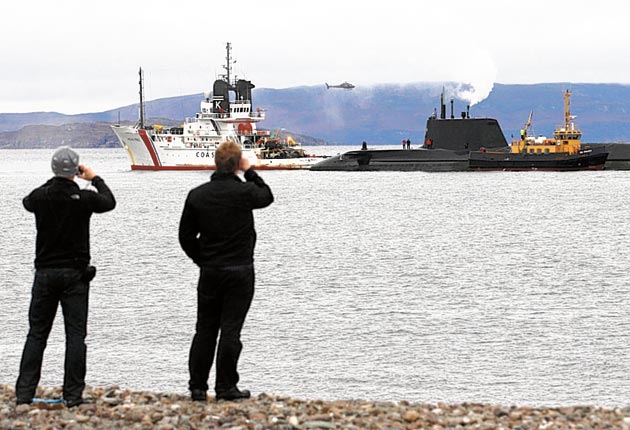Billion-pound nuclear sub meets its match – some Scottish rocks

Your support helps us to tell the story
From reproductive rights to climate change to Big Tech, The Independent is on the ground when the story is developing. Whether it's investigating the financials of Elon Musk's pro-Trump PAC or producing our latest documentary, 'The A Word', which shines a light on the American women fighting for reproductive rights, we know how important it is to parse out the facts from the messaging.
At such a critical moment in US history, we need reporters on the ground. Your donation allows us to keep sending journalists to speak to both sides of the story.
The Independent is trusted by Americans across the entire political spectrum. And unlike many other quality news outlets, we choose not to lock Americans out of our reporting and analysis with paywalls. We believe quality journalism should be available to everyone, paid for by those who can afford it.
Your support makes all the difference.HMS Astute had been billed as the stealthiest of underwater fighting machines; one the enemy would find virtually impossible to see and track.
But its biggest adversary during sea trials turned out to be some unremarkable rocks off the Isle of Skye, with which the £1.2bn nuclear-powered submarine collided.
The Royal Navy's newest and largest attack submarine had, by yesterday morning, become a tourist attraction on the island, where dozens of locals gathered to take pictures and watch attempts to free the vessel.
A Ministry of Defence Spokesman repeatedly stressed that this was "not a nuclear incident" and that the boat was watertight. He added: "The incident occurred during a boat transfer from the submarine in confined water. The rudder went aground and it was held by the rudder on the rocks."
It was, however, an embarrassing end to a week during which the defence budget had been slashed. The Royal Navy celebrated Trafalgar Day on Thursday, in the knowledge they had won the fight to get two new aircraft carriers built, even if Britain will not have any carrier cover for a decade due to a lack of aircraft.
The coastguard said yesterday that an attempt to tow the submarine out had failed. Navy vessels and a tug will make further attempts at high tide.
Some residents admitted to being worried about the risks which they feel are inherent with any accident involving a nuclear submarine. Rachel Browett, who runs the Bright Water Visitor Centre, said: "It's a concern. Anything with the word nuclear in it is obviously a worry, but I don't know enough about it to say more. It's not too far from the shore and clearly visible from the bridge. I could see steam or smoke coming from the top and about half the sub was visible. A few boats were around about it in the water and a helicopter went overhead at one point, though I don't know if it was involved [in the attempts to free the sub]."
John Laing, local councillor for the area, said: "The people of Kyle and Broadford are well used to seeing both nuclear and conventional subs going up and down because of the torpedo testing range, so the sight of subs is not unusual.
"But, of course, we are deeply concerned that HMS Astute has gone aground and we just hope there is no danger. I would like to know what the circumstances were that caused it to come aground."
Subscribe to Independent Premium to bookmark this article
Want to bookmark your favourite articles and stories to read or reference later? Start your Independent Premium subscription today.
Join our commenting forum
Join thought-provoking conversations, follow other Independent readers and see their replies
Comments